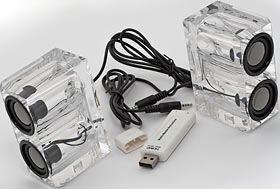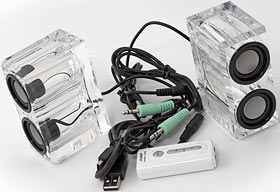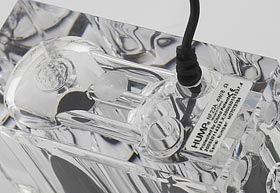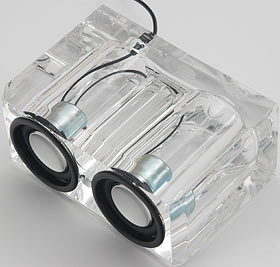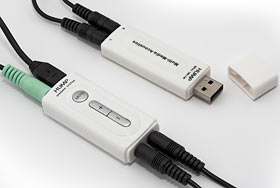
Unique Hardware NF01 and NF02 USB speakers
Review date: 17 August 2007 Last modified 03-Dec-2011.
Little tiny computer speakers suck.
They have to.
It's a rule of the universe.
You see, little tiny speakers have little tiny "drivers" - the actual moving things that turn electricity into sound.
There's a name for a little tiny driver. That name is "tweeter".
It is exceedingly difficult to get even low midrange, much less bass, out of a small driver. The resonant frequency of a small driver is inescapably high, and getting any driver to deliver output below its resonant frequency is like trying to push someone on a swing slower than the swing wants to, well, swing. It's technically possible - if you scurry to and fro while holding onto the swing - but it's very impractical, and requires a lot of energy.
The usual way in which speaker designers get some semblance of bass out of small drivers is by putting them in an enclosure which has its own resonance. In cheap speakers this resonance is likely to be very pronounced, creating a muddy mess at the lower end of the frequency range, but giving as much potential for floorboard movement as a cheap speaker with small drivers can possibly manage. This is the normal design philosophy for boom boxes and cheap computer subwoofers; it sounds passable if you only hear it for 20 seconds in a noisy appliance store, and that's all that's necessary to sell such products.
(You'll actually probably much prefer the sound from a couple of simple little bookshelf speakers plugged into a $20 garage-sale amplifier, by the way. Even if you're a teenager. Trust me on this.)
Most tiny computer speakers, however, don't even manage the level of refinement of a boom box. They may appear to have tuned ports or novel construction or special long-throw drivers in them, but as I've mentioned on previous occasions, this is purely cosmetic. The ports are just sculpted holes in the casing with no actual tuning, the funky design is just tinsel, and the drivers are the same ones you get in off-brand televisions.
So when I saw these things...
...I was not optimistic.
They're little tiny computer speakers with a USB amplifier module, so you just plug them into a USB port on any reasonably modern computer and bing, you've got a new audio device.
They are made by the Unique Hardware Company of Hong Kong.
Their model name, without a word of a lie, is HUMP NF01.
Yes, HUMP.
Stop snickering, Watson.
HUMP stands, perfectly obviously, for "Humming Ports". This is Unique Hardware's idea for getting reasonable sound out of teeny drivers in teeny cabinets.
And there's more.
These ones are the HUMP NF02s. Same speakers, fancier electronics module, with volume and mute buttons and a line-in socket.
Odd name aside, these speakers certainly look neater than most of the tiny-speakers out there. And - more importantly - they look solidly built.
Good speaker design is all about the cabinets. You can take cheap car audio drivers - and I mean really cheap ones, the ones with a paper roll surround that've been standard equipment in base-model cars since 1975 - and get very pleasing sound out of them indeed, if you put them in a good cabinet.
Sure, you can get better sound if you put fancy drivers in a good cabinet. But a couple of paper-surround six-by-nines from the kick panels of a junkyard station wagon really can put a whole orchestra across the front of your living room if you give them somewhere nice to live.
You won't get sparkling treble, you won't get any low bass at all, but you will get stereo image to die for. And when you've saved up a few more bucks, bass-shortage is eminently curable.
To cut to the chase: The Humming Ports design works. I think Unique Hardware are rather overstating the case when they say that these tiny speakers have "audiophile quality sound", but the Marketing Lie Factor is a great deal smaller than you might think.
It's quite easy to buy speakers that're as big as, oh, six NF01s stuck together, yet sound, on balance, worse.

In the above Sizeasy graphic, the NF01 is the purple block between the matchbox and the pack of cards. Each speaker enclosure is only 87 by 60 by 40mm (3.4 by 2.4 by 1.6 inches).
And yet they sound pretty decent.
There are two things about the NF01/02 speakers that make the difference, here.
The first, as I said, is how they're built. The speakers are made from shiny, crystal clear acrylic, and they weigh about 200 grams (seven ounces) each.
That's a lot, for speakers this small.
A typical small bookshelf speaker, maybe ten by seven by seven inches, feels pretty solid if it weighs three kilos. Scaling up the density of the NF01s to that size would give you an eight kilogram speaker.
Click these speakers together and they sound not like resonant enclosures, but like paperweights.
The drivers in the NF01s aren't nearly as remarkable as the cabinets. They've got a concave brushed-aluminium "cone" in the middle, and a black rubber roll surround, and they're all over the place these days.
If it's tiny and has speakers in it, it seems at least an even-odds bet that those speakers will look just like these. You mainly see these drivers in iPod docks (some more hilarious than others), but they're popular for other tiny speakers as well. You can even find them attached to a white Optimus Prime.
These little drivers only have about a 29mm (1.14 inch) diameter even if you measure from the very edge of the roll surround. Their real acoustic "piston" diameter is less than an inch.
(According to ancient audio marketing tradition, Unique Hardware specify the NF01 drivers by the diameter from the very edge of their physical structure, making them "33mm" drivers. The actual moving part of a driver is what determines its basic sonic capabilities, though. It's therefore better to compare the piston area of different drivers than to compare their absolute peripheral dimensions.)
Conventional voice coil drivers as small as the ones in the NF01s have been around for a long time. They always used to be all-paper designs with very little cone movement possible, or see-through super-flat Mylar jobbies, like the ones used in most headphones, which are far too fragile to leave hanging in the breeze on the front of a speaker cabinet.
This new wave of aluminium-coned rubber-surround drivers (well, relatively new - the Altec Lansing Select 4100 set I reviewed five years ago had similar drivers in the satellites, and they seem to still be using them) are, in contrast, quite tough. You can still easily wreck one by stabbing it with your finger, but not just by pushing on it to see how far it moves (something I, as a technical professional, do all the time despite the dire warnings against cone-prodding that most speaker manuals include).
The total fore-and-aft movement for the NF01 drivers is larger than you might think. The rubber surround, along with a much larger voice coil assembly than is normal for tiny-drivers, means these things can manage at least a little bit of what audio nerds refer to as "cone excursion".
Cone excursion and bass response are closely linked. So the notion of getting something out of these minuscule drivers that might from a distance resemble bass is not entirely absurd.
More about that in a moment. Here's the second thing about the NF01s that makes them very different from the typical tiny-speaker.
Each little acrylic-block speaker has a cylindrical tube behind each of its two drivers, and those two tubes are connected at the back by three narrower channels that go all the way to the bottom of the speaker. These channels aren't really "ports", though; they're capped on the bottom of the speaker. I presume the only reason they exit the case at all is because there's no other way to fabricate the enclosures in one piece.
The above picture is of an earlier prototype version of the HUMP speakers I got for review, several months ago; it's acoustically the same as the retail version pictured earlier...
...and here, but there are a couple of differences.
The prototypes capped the unused channels with self-adhesive rubber feet, which you could easily peel off if you wanted a worse-sounding speaker. The retail units plug the channels better, with some silicone goop.
The prototypes also had skinny, vulnerable cables with poor strain relief, which were just asking for trouble. The retail units have tougher cable and proper strain relief, so as long as you don't really yank on the cables, they ought to hang in there.
The prototypes had drivers with silvery cones and a plain metal cover over the magnet assembly on the back. The retail units have darker grey cone metal and a black magnet cover. I only mention this to avoid confusion in the pics and videos below, which are mostly of the prototype speakers.
On the right hand side of the above picture you can see a little cylindrical socket moulded into the bottom of each speaker cabinet. The socket's a hair under 10mm in diameter and a little more than 4mm deep. I presume it's for a speaker stand that doesn't yet exist. While you're waiting, you could easily come up with something - a bolt just big enough to bite into the acrylic around the socket, say - that'd let you install the speakers somewhere other than just sitting on a surface.
(The speakers are small enough that you could also easily hold them in place with some kind of clamp.)
For all the channels and hollows in these speakers, there's only one actual port in each little cabinet. It's a traditional front-exit type, which connects the central vertical channel at the back of the speaker to the middle of the front panel. As normal for ported speakers, you can feel a distinct breeze in front of the tiny ports when the NF01s are playing hard.
Here they are, hard at work. The audio's not so hot because it was too loud for the microphone on my little camera, but you can see plenty of cone movement.
Here's even more, as the NF01s attempt - and fail - to play back a track with a 30Hz bass drum.
The NF01 channel design is a lot more complex than the usual ported loudspeaker layout. Normal ported speakers - the ones in this review are typical examples - just have an ordinary box with one or more holes in it, with tubes of some sort - usually either plastic pipe or channels made out of wood - behind the holes. The tubes are sized to resonate at a particular frequency, which works with the resonance of the driver and of the air inside the rest of the enclosure to give you, essentially, more bass. And considerably higher efficiency (volume per watt) than you'll get from a simple sealed box.
The HUMP design, with its two interconnected chambers, may or may not be a technical advance over an ordinary ported box. For all I know, though, it's actually just more acrylic-moulding limitations that're behind the odd layout. There's really no comparison between these things and the average tiny ported speaker, though; the NF01s sound far better.
Testing
It's a hallowed tradition among makers of cheap speakers to print hilariously fraudulent frequency response plots on the marketing material. My personal favourites are those plastic car parcel shelf speaker surrounds, that let you install speakers there without cutting holes (it's such a shame that these didn't catch on instead). The surrounds often have response graphs printed on them; the graphs for a given model of surround are always exactly the same no matter what actual speakers are installed.
When these speakers were still in the prototype phase Unique Hardware had their very own ridiculous response plot, but now their page about the speaker technology contains some (apparently independently created) response plots which look plausible to me. These speakers do sound surprisingly good, but you canna change the laws o' physics.
When I tested the response of the NF01s with my Mark 1 Ears and some signal generator software, I put the real absolute outside bass response limit at about 90Hz, with the -3dB point (the point in the graph which is traditionally called the "limit" of bass response, since any response below that won't be audible over normal program material) quite a bit higher.
You can wring more bass than you'd think out of these things, though, if you're willing to play with equalisation. When you're sending music to speakers that can't reproduce low bass, you can use the EQ to massively cut the level of that low bass, and to boost the higher bass frequencies that the speaker can reproduce.
If you cut low bass and don't boost anything, you'll be improving the speakers' performance by reducing distortion and wasted amplifier power. If you add the boost as well, you'll get a better sound at modest volume levels, at the price of reducing the maximum possible volume.
On the subject of maximum volume, I found the NF01s weren't too fussy about the USB ports from which they would deign to run. For ordinary not-annoying-your-officemates kinds of volume levels, you should be able to run the NF01s from a port on an unpowered USB hub, or even put them on the end of a USB extension cable. Which is more than can be said for some USB devices.
If you turn the NF01s up too far when they're running from restricted-power USB like this, though, they'll freak out. The prototypes shut down entirely when they ran out of juice, and I needed to unplug and replug them to make them work again. The retail versions seem to be able to turn themselves off and back on again, at their default medium volume. This makes it easier to set the volume appropriately (remember to use EQ to cut the low bass if you want absolute maximum noise!).
When the speakers are running from their own root port, or a port on a powered hub, I think you should be able to push every volume setting up to max without any problems. Well, except for distortion, anyway.
There's not too much of that, though. The NF01s' little amplifier seems quite well matched to the drivers, neither gasping horribly for breath at maximum volume nor slapping the tiny drivers' voice coils against their stops.
I tested the NF01s from a root USB port, and set up my sound level meter one metre away from the speakers, which were sitting right next to each other. With every volume slider maxed out and flat EQ settings (no low-bass cut), my first carefully calibrated test tone gave a peak level of 71.5dBA. This wasn't in an anechoic chamber, but soft furnishings got me close enough for government work.
71.5dBA isn't party volume, but neither is it the useless whisper of your typical unamplified headphone-socket speakers. A bit more than 70dBA is quite acceptably loud for most music listening, and it should be quite easy to achieve with the NF01s. If you're using the laptop at the time you'll probably be sitting rather closer than one metre from the speakers.
An arguably better calibrated test tone, just a 1kHz sine wave with no tiny-driver-troubling bass, gave a cat-bothering 78dBA at one metre. I suppose that's the number I'd put on the spec sheet if I were trying to sell the speakers, but it doesn't tell you as much about their real-world capabilities as the 71.5dBA HeavyMetalMark figure.
Power
People get hung up about audio system power, but it doesn't often matter much. Most home hi-fi listening is done at power levels of only a couple of watts per channel, or less. Which is good, because 20 watts per channel only actually sounds about twice as loud as two watts, and 200 watts only twice as loud again.
When your speakers are being powered by USB, though, power becomes important. That's because even if you're running from a root port or powered hub, you still only get 2.5 watts. USB power is, officially, five volts at up to half an amp, and that's all you get. The NF01 and NF02 are both specified at a mighty one watt per channel.
There are ways around the USB power limit. A lot of cheap USB hard drive enclosures, for instance, now come with a Y-shaped cable that plugs into two USB ports on the host computer. One port is used for power and data, and the other one just leeches another 2.5 watts of power. Or doesn't, if you're absent-mindedly using two ports on one powered hub, which will only have 2.5 watts to share between all of its ports.
USB has a power management system that allows connected devices to tell the host computer how much power they need. It doesn't actually measure the consumed power, though, which is why simple dumb leech devices like those Y-cables, and all of those little novelty USB lamps and fans and so on, work.
Without pulling apart a given USB device (or at least its cable), it's therefore impossible to tell how much juice it's actually drawing. The NF01s' shutdown trick when you try to run them at full volume through an extension cord suggests that they're pushing the limits - but, pleasingly, they seem to work perfectly well with other USB devices when you're not pushing the envelope like this. They report themselves as a "500mA" device, the highest possible power allocation.
You shouldn't expect to be able to run an external hard drive and the NF01s at any significant volume from one 2.5-watt block of USB power, but they're fine sharing a hub with low power devices like a mouse and keyboard. They also worked OK when I tested them running from an unpowered hub, which can only deliver as much power as the port you plug it into can deliver, less the handful of milliwatts the hub's own electronics consume.
Wiring
Another of the failings of the prototype NF01s was that their USB amp module...
...was permanently wired to the speakers.
The retail units have these separate USB amp modules, into which the speakers plug. The NF01 amp module has a simple "memory stick" form factor with a USB plug on one end and the sockets for the speakers on the other, with no controls (but an internal blue LED that lights the amp up when it's on).
The fancier NF02 module has the same speaker sockets on one end, but a mini-USB socket for data input on the other (it comes with a suitable cable), and a standard 1/8th inch socket next to it for standard line in - from an MP3 player, say. The amp still needs to be connected to USB power in order to work; plugging something into the aux-in socket mutes the USB audio and gives you the aux-in sound instead.
The NF02 module also has volume buttons and a handy mute button as well. It's got the same internal blue power LED, too.
The only weird thing about the plug-in speaker arrangement is that Unique Hardware have decided to equip the speakers with the subminiature 2.5mm (or 3/32 inch) type of jack plug, instead of the 3.5mm (1/8th inch) plugs that're normal for computer audio use.
These particular plugs have, for some reason, four terminals (making them "TRRS connectors" using the technical tip-ring-sleeve nomenclature). Only two of the terminals are actually connected to anything, though; the sleeve and one of the ring terminals are unconnected, leaving the tip and the other connected ring separated by the one unused ring. My multimeter showed about 12 ohms across the connected terminals, so I presume the little speaker drivers are connected in series.
The submini plugs are, I suppose, there to stop you from accidentally plugging the speakers into a headphone output, or something - not that it'd be likely to hurt them if you did. I suspect the two-out-of-four wiring arrangement is there to stop the NF01/02 amplifier output from being briefly short-circuited while you plugged the speakers in. That can be very bad for a simple amp.
The speakers each have about a metre of cable on them, so you shouldn't have trouble putting them where you want for any desktop-audio sort of setup.
Buying them
When this review first went up, Unique Hardware were selling their speakers directly on eBay, using the completely un-hilarious seller name "humpunique". They ship all over the world, so a search for "nf01" or "nf02" should turn them up on your country's eBay site. Here's their store on ebay.com; here it is on ebay.com.au.
When this review was new, the price for a set of NF02s was up around $US75 including delivery. It's now fallen to something like $AU65 delivered, depending on exchange rates and whether the auction was listed in Australian or US dollars.
The NF01s are also now available from ThinkGeek - but Unique Hardware tell me that they haven't wholesaled any speakers to ThinkGeek, so they presume someone else is selling on speakers they've previously bought. Weird.
Anyway, ThinkGeek have as usual re-named the product, to stop people from realising that the same thing is available elsewhere. They call the NF01s "Crystal USB Desktop Speakers". But they're selling them for only $US39.99 plus shipping for a pair of NF01s, which is very reasonable.
Overall
75 US bucks was quite a lot of money, for a pair of little USB speakers. $AU65-odd isn't so bad, though, and $US40 plus delivery's not bad at all.
You can get USB speakers - tiny ones with one-per-cabinet of the same distinctive drivers as the Unique Hardware speakers, or bigger ones with good old paper-cone drivers in them - for $AU20 to $AU25, including delivery, on eBay.
Heck, I'm looking at a pair right now that cost almost twenty-six Australian dollars including delivery, but claim to offer 350 watts of power. That's pretty impressive for something running from a 2.5 watt USB port!
That power figure is, of course, one of those good old PMPO, or "Peak Music Power Output" numbers, also known as a complete lie. Just about everything on the specification sticker of dirt-cheap "multimedia" speakers is a complete lie. Power handling, frequency response, quite often even the alleged size of the drivers. Pure bull.
The difference between the outfits that make those cheap USB speakers and Unique Hardware is that Unique Hardware are not a bunch of liars.
OK, it's pushing it a bit to call the NF-series speakers "audiophile" products. But, dammit, by the standards of small computer speakers, they are. Rock-solid cabinets and inventive porting arrangements are something you just don't see in the small-computer-speaker market - well, not unless you start shelling out big bucks for something from a serious hi-fi brand name whose price tags are 65 per cent marketing, anyway. And even then you'll have a hard time finding anything nearly as small as the NF-series cabinets.
The closest thing I've been able to find to the NF01/02 speakers is Roland's Edirol MA-1EX USB speakers. They're still just about pocketable, if you're wearing a coat. And they've got a proper ported design and "2.5-inch" (more like two-inch, tops) drivers, so they probably sound better than the Unique Hardware speakers.

But you'd bloomin' want them to, since the Rolands - in red - have about three times the cabinet volume of the NF-series speakers - in yellow.
In the States, the Rolands cost a pretty reasonable $US50 or so, ex delivery. Here in Australia, though, they're significantly more expensive than the Unique Hardware speakers, at about $125.
Right now I'm listening to Vivaldi on the NF02s, with the 60Hz slider pulled down a bit in the Winamp EQ settings, but no other tweaks. The sound is balanced and unfatiguing, with real stereo imaging. There are no honks in the midrange, no piercing highs, no alarming buzzes from lightweight plastic cabinets.
No, the NF02s are not as good as the cheap bookshelf speakers I've got hanging on the wall. But I can't stick the bookshelf speakers in my pocket.
Oh, and the previous track in the random play was AC/DC's "Back In Black".
No, the NF02s did not manage to rock off my socks. But neither did they dissolve into muddy horribleness.
Vocal music, old jazz, orchestral stuff, Les Baxter loungeified classics, even solo piano music - always a killer for lousy speakers - all sound startlingly decent on the Unique Hardware speakers, especially if you take a moment to tweak the EQ to suit your preferred music genres.
Amazingly, even outrageous thud-and-blunder organ music ain't too bad. Sure, all of the furniture-rearranging bass is gone, but the tune is still there.
(Hound Dog Taylor sounded pretty lousy though the NF02s. My working hypothesis for that is that the ripped speakers in Taylor's band's amplifiers were only able to reproduce frequencies that the Unique Hardware speakers can't.)
If you don't need little tiny super-portable speakers, you don't need the NF01s. If you still need a USB audio solution, there are umpteen super-cheap "USB sound cards" on eBay. Get one of those, plug it into any old amplifier and garage-sale speakers, and you'll be golden.
If you want pocketable speakers that don't sound like wet mud and/or the audio leaking out of someone else's headphones, though, the NF-series speakers are an absolute revelation, and definitely worth the money.
Even if you don't really need them, you might well prefer them to larger, beige, boring desktop computer speakers. The Unique Hardware cabinets are little shining jewels in comparison.
Highly recommended.
Review speakers kindly provided by
Unique Hardware.
The Unique Hardware eBay store is
here, or
here on eBay Australia.
ThinkGeek sell the NF01 speakers for $US39.99, as "Crystal
USB Desktop Speakers".
